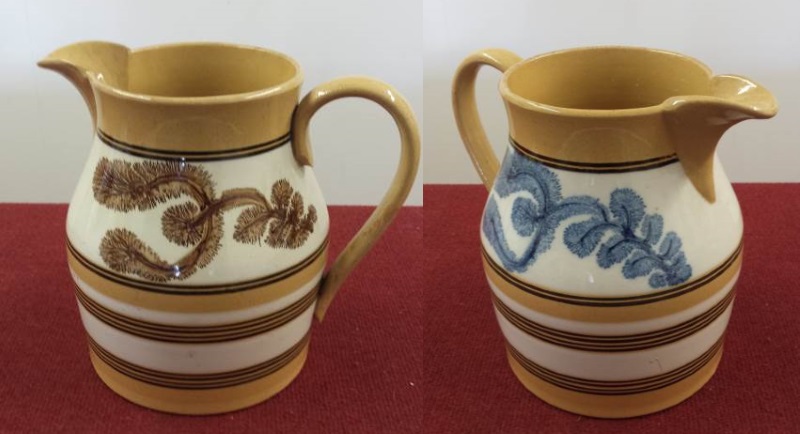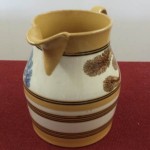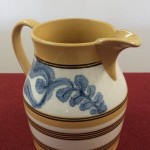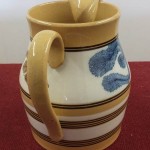
Unique Auctions two day Antiques & Collectors auction on the 23rd and 24th April includes this large Mocha Ware Jug (mochaware). The jug measures approximately 9″ high and features blue and brown leaf patterns.
The auction takes place on 23rd and 24th April starting at 9am each day. Viewing is on Friday 22nd April 9am-6pm and the morning of the auction from 7am.
What is Mochaware (source wikipedia)
Mocha decorated pottery is a type of dipped ware (slip-decorated, lathe-turned, utilitarian earthenware), mocha or mochaware, in addition to colored slip bands on white and buff-colored bodies, is adorned with dendritic (tree-like or branching) markings resembling the natural geological markings on moss agate, known as “mocha stone” in Great Britain in the late 18th century. The stone was imported from Arabia through the port of Mocha (al Mukha in Yemen) from whence came large supplies of coffee. An unknown potter or turner discovered that by dripping a colored acidic solution into wet alkaline slip on a pot body, the color would instantly ramify into the dendritic random markings that fit into the tradition of imitating geological surfaces prevalent in the potteries of that period. The earliest known dated example (1799) is a mug in the collection of the Christchurch Mansion Museum in Ipswich, England. Archival references are known that suggest production began as early as 1792.
Manufactured by potteries throughout Great Britain, France, and North America, mocha was the cheapest decorated ware available. Most British production went to export whereas France and North America manufactured for the home markets. Archaeological finds throughout the eastern United States suggest that mocha was used in taverns and homes, from lowly slave quarters to Thomas Jefferson’s Monticello and Poplar Forest. After the mid 19th century, British imports waned, with those potteries still making mocha concentrating on government-stamped capacity-verified measures (jugs and mugs) for use in pubs and markets. North American product was based entirely on yellow or buff-colored bodies banded in black with broad white slip bands on which the dendritic markings appeared. Some British makers used yellow-firing clay, too, but the bulk of the wares were based on white bodies, the earliest being creamware and pearlware, while later, heavier and thicker bodies resembled ironstone, known best to archaeologists simply as “whiteware”.
About Unique Auctions
Unique Auctions are one of Lincolnshire’s leading Auction Houses offering a range of regular Antique & Collectors sales. Unique Auctions handle every aspect of probate, house, agricultural, commercial and industrial clearances. For further information call UK +44 (0) 1522 690444 or visit https://www.unique-auctions.com
We offer a full estate and part estate clearance service covering the whole of Lincolnshire, the East Midlands and throughout the UK.




